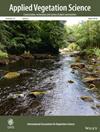Understorey vegetation response to post-tornado salvage logging
Abstract
Questions
How does salvage logging alter understorey vegetation composition? To what extent does abundance of recalcitrant understorey species influence conifer tree regeneration? How does salvage logging influence microclimate conditions?
Location
Scientific Forest Management Area, Baxter State Park, Maine, USA.
Methods
In 2013, a rare tornado and subsequent salvage operation created three clear “treatments” for evaluation of post-disturbance understorey community response: blowdown, blowdown followed by salvage logging and an undisturbed forested control. Ten years post tornado, we inventoried understorey vegetation at 10 sampling points within each of these treatments. We installed automated sensors to track temperature and soil moisture throughout a growing season and used hemispherical photographs to characterize canopy openness.
Results
Non-metric multidimensional scaling (NMDS) ordination based on species importance values indicated distinct species groupings according to treatment, with the salvage treatment supporting a higher abundance of the recalcitrant species, Rubus idaeus and Pteridium aquilinum. Abundance of conifer regeneration was notably lower in areas with high abundance of Rubus idaeus or Pteridium aquilinum. Daily soil surface temperature fluctuations and canopy openness (both factors that influence seed germination) decreased in the order salvage > blowdown > control. Ordination results suggest that these two factors were the primary drivers of the observed compositional differences.
Conclusions
This study furthers our understanding of the interactions among disturbance, microclimate, and understorey communities, highlighting the need for increased consideration of long-term effects on vegetation development following salvage logging. Our findings support recommendations to intermingle salvage patches within blowdown areas to promote landscape heterogeneity and species diversity.

 求助内容:
求助内容: 应助结果提醒方式:
应助结果提醒方式:


